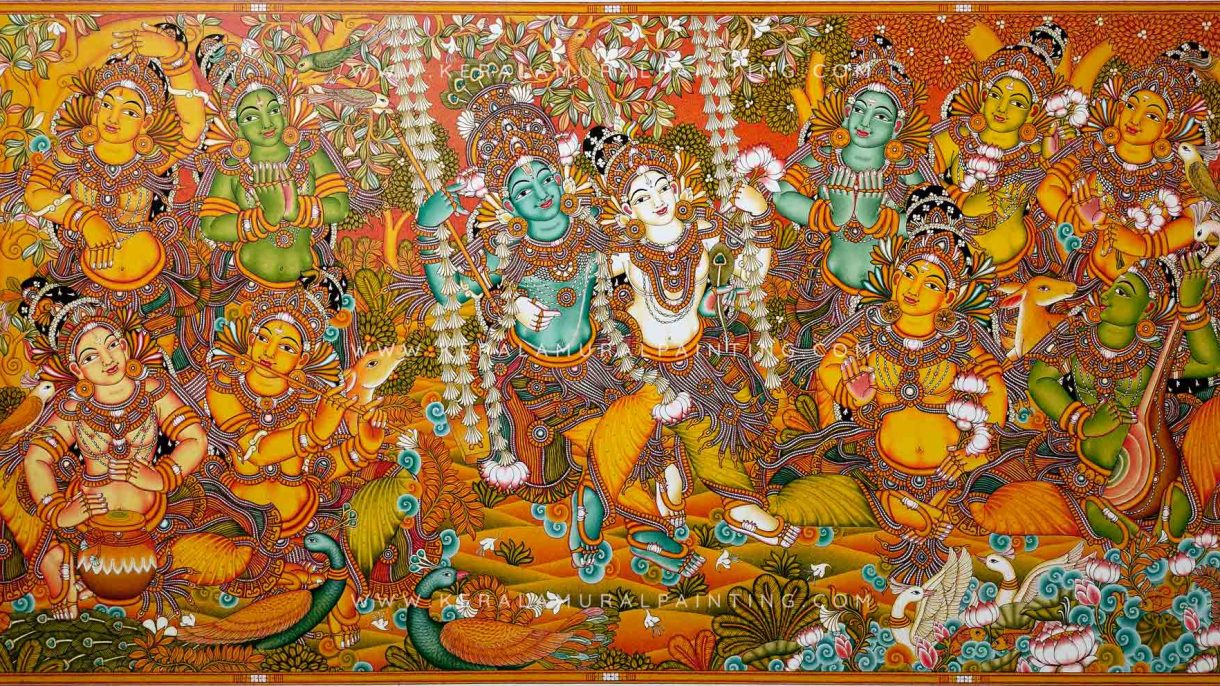Introduction
Kerala, a state situated in the southwestern part of India, is not only known for its lush landscapes and backwaters but also for its rich cultural heritage. One of the vibrant facets of Kerala’s cultural tapestry is its traditional mural paintings. These paintings, deeply rooted in history, are characterized by intricate designs, vibrant colors, and themes that often depict mythological stories and religious motifs.
Historical Background
The tradition of mural painting in Kerala dates back to ancient times, with evidence suggesting that it flourished during the rule of the Chera dynasty (c. 300 BCE – 1102 CE). The art form gained prominence in temples, palaces, and churches, becoming an integral part of Kerala’s architectural and cultural identity.
Characteristics of Kerala Mural Painting
1. Technique:
- Fresco Technique: Traditional mural paintings in Kerala are executed using the fresco technique, where pigments are applied on wet plaster. This ensures the longevity of the artwork as the colors seep into the plaster, creating a lasting bond.
2. Color Palette:
- Vibrant Colors: Kerala mural paintings are renowned for their vibrant color palette, comprising a range of natural pigments. The artists use a variety of mineral and vegetable colors, derived from stones, minerals, leaves, and flowers.
3. Themes and Subjects:
- Mythological Narratives: Many of the mural paintings in Kerala depict scenes from Hindu mythology. The walls of temples often feature episodes from the epics Ramayana and Mahabharata, as well as stories of various gods and goddesses.
- Religious Motifs: Mural paintings are not limited to Hindu temples; Christian churches in Kerala also boast intricate mural art with themes from the Bible.
4. Symbolism:
- Symbolic Elements: Artists incorporate symbolic elements into their works, conveying deeper meanings related to spirituality and cultural values. Animals, plants, and geometric patterns often carry symbolic significance.
5. Style and Form:
- Linear Grace: Kerala mural paintings are characterized by linear grace and stylized forms. The artists skillfully blend form and rhythm to create visually captivating compositions.
Notable Examples
1. Padmanabhapuram Palace:
 The Padmanabhapuram Palace, located in the Kanyakumari district (Tamil Nadu), was the ancient capital of the Travancore kingdom. The palace features exquisite mural paintings, depicting scenes from Hindu mythology.
The Padmanabhapuram Palace, located in the Kanyakumari district (Tamil Nadu), was the ancient capital of the Travancore kingdom. The palace features exquisite mural paintings, depicting scenes from Hindu mythology.
2. Mattancherry Palace (Dutch Palace):
 Situated in Kochi, the Mattancherry Palace is known for its remarkable mural paintings. The themes range from the Ramayana to portraits of the Rajas of Kochi.
Situated in Kochi, the Mattancherry Palace is known for its remarkable mural paintings. The themes range from the Ramayana to portraits of the Rajas of Kochi.
3. Guruvayur Temple:
- The Guruvayur Temple, dedicated to Lord Krishna, houses beautiful mural paintings depicting episodes from Krishna’s life and other mythological stories.
Preservation and Revival
While traditional mural painting faced challenges in the modern era, efforts have been made to preserve and revive this ancient art form. Art schools, workshops, and cultural organizations are playing a crucial role in training new generations of artists and ensuring the continuation of Kerala’s mural painting heritage.
Conclusion
Kerala’s traditional mural paintings stand as a testament to the state’s rich cultural and artistic legacy. The intricate details, vibrant colors, and timeless themes continue to captivate art enthusiasts and tourists alike, providing a glimpse into the cultural tapestry of this enchanting region. Efforts to preserve and promote this art form are vital for ensuring that Kerala’s mural painting tradition thrives for generations to come.
KERALA MURAL

